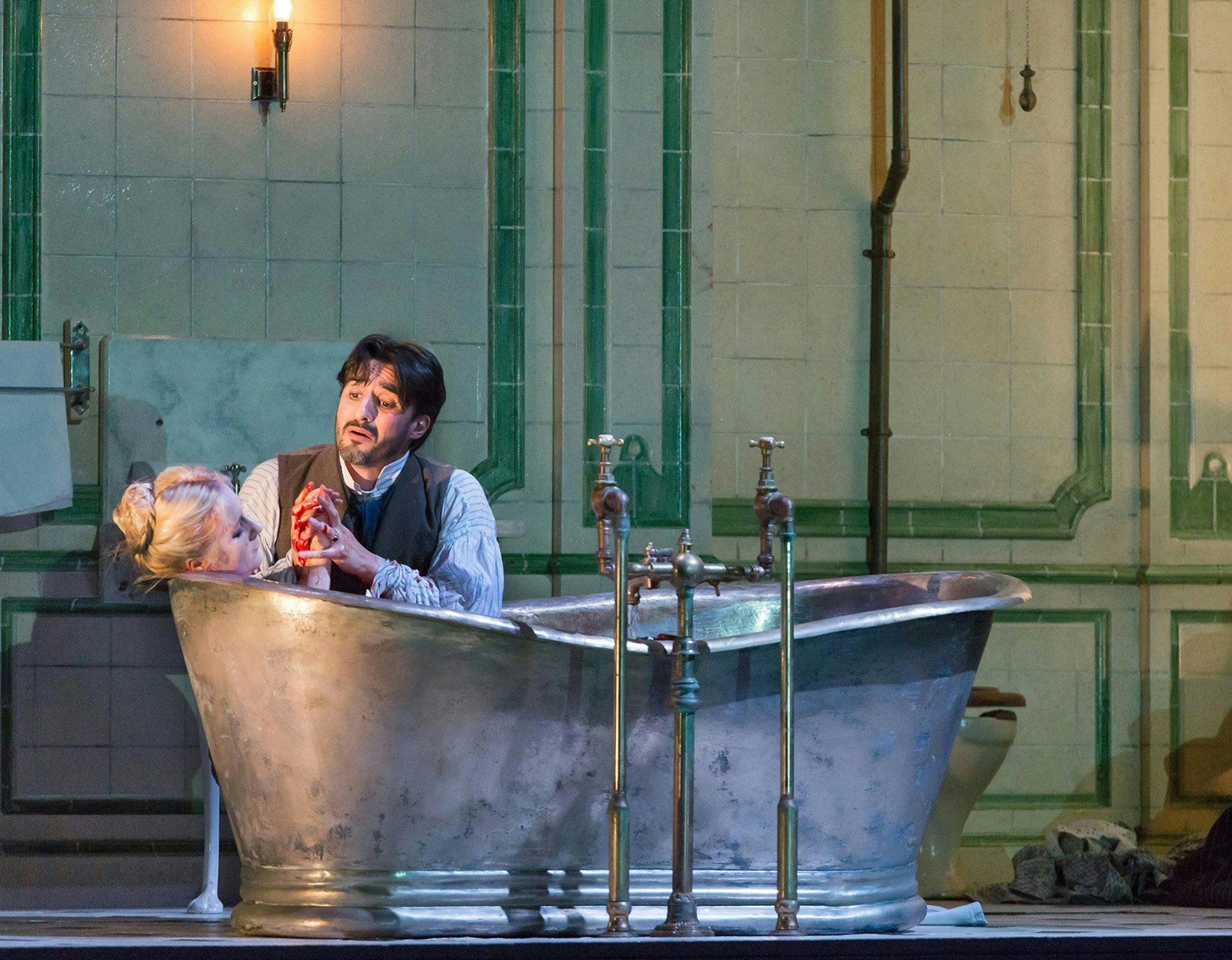This article is taken from the May 2024 issue of The Critic. To get the full magazine why not subscribe? Right now we’re offering five issues for just £10.
You know the story, but here’s a reminder: Scottish Wedding — Three Dead. If any operatic image can elbow out the chesty soprano snuffing it on the bed, it’s got to be the wild-eyed bride of Lammermoor in her blood-spattered wedding dress: little Lucy Ashton, after gutting her unwelcome bridegroom, holding the stage for 15 minutes of raving, fantasy, reminiscence, wish-fulfilment … and finally, and most eloquently, a wordless cascade of notes spinning out like a Catherine wheel’s brilliant dying sparks. Poor mad Lucia, giving it the large one for all the traduced, traded, tricked and sacrificed women that ever lived.
Lucy is the glacé cherry on top of the fruitcake of opera, whose obsession with extreme mental and emotional states is the only justification for its existence — and yet another reason why it’ll have its collar felt by the PC plod before long: a pastime so devoted to mental deformity (viz Wagner’s Hagen, Alberich, and allied perverts and necrophiliacs; the nauseating self-harming blood-maniacs Tristan, Klingsor and Amfortas; death-crazed maenads like Verdi’s gypsy Azucena and Cherubini’s Medea) clearly constitutes a criminal enterprise now that celebrating such riches of neuro-diversity, rather than mining their horror, is a legal obligation.
But opera begs leave to celebrate lunacy in a different way. Taking its cue from Euripides’ Bacchae, it affirms that life means nothing without the madness of uncontained ecstasy. Reality begins only where pitiful, enchained reason ends. The vehicle that gets you there hardly matters: it could be grief, lust, fury, hilarity, probably even a surfeit of lampreys.
It can infect individuals or the whole dram pers, as when Rossini’s stage becomes a bedlam of the demented, reduced by perplexity and trauma to a pre-linguistic chaos of barking and hooting in the Act 1 finale of L’italiana in Algeri.
This capacious asylum keeps rooms for the bad and the sad, alongside the copper-bottomed mad and the merely stinko. Insanity can be of a familiar, passing kind, from the “bad girlfriend experience” to the tabloid-approved “moment of madness” that leads José to kebab his Carmen (surely a decent brief could parlay a diminished-responsibility rap, though his “going equipped” could be an issue).

Naturally enough, it is practically always love — betrayed, over-indulged, disprized — that pushes them off the cliff, though reactions vary: Shostakovich’s Katerina Izmailova embarks on a Bonnie & Clyde-style murder spree in the unpromising purlieus of Mtsensk, whilst Orlando — the Mediaeval James Bond descended from Charlemagne’s winger Hruodland (crazy name, crazy guy) — goes in for a Europe-wide campaign of psychotic violence, detailed in many a Baroque opera.
If sex droughts can be inflaming, the same holds for gluts: see Handel’s Ruggiero, brains fried by Alcina’s erotic refinements, a drooling sex-toy with his wits shagged to porridge. It’s indicative that when Ruggiero comes to his senses, Handel pointedly winds the opera up in humdrum melancholy, as everyone adjusts their clothing and returns to the morgue of suburban respectability.
Operatic madness soon became a female preserve, with male composers getting laughs out of feminine hysteria, as when Mozart turns his mother-in-law’s demented shrieking into the Queen of the Night in Amadeus. Ladies began to succumb to the vapours in increasing numbers, and a “mad scene” became de rigueur from around 1830.
The petulant Vincenzo Bellini, spurred into competitive loon-spinning, dumped on his weak-minded heroine Elvira (in I Puritani) not one but two episodes of melancholiac raving to outdo Gaetano Donizetti’s Anne Boleyn, gibbering away there in the Tower.
These neurasthenics had a knock-on effect in actual medicine. Forty years after the Paris premiere of Lucia, Jean-Martin Charcot, “the Napoleon of hysteria”, treated audiences (including Freud) to actings-out of mania at the Salpêtrière hospital, his patient Louise Augustine Gleizes dishing up delirious fantasies that echo Lucia’s ravings: an ecstatic encounter with the unseen beloved, the sensation of a kiss on her cheek, hallucinations of violence.
Opera had conjured into existence a whole new pathology: Freud continued to pursue it, but soon the illness of hysteria simply vanished like the morning dew.
It’s all a bit tricky now that women are universally known to be “strong”, as in Katie Mitchell’s staging of Lucia, playing at Covent Garden until May 18th. Donizetti, who could wring more heart wrenching pathos out of basic harmonic progressions than anyone who ever lived, went to some lengths to highlight Lucy’s wretched helplessness: she is the only significant female voice in a gloomy, masculine sound world, and Walter Scott’s true villain, Lucy’s mother, is written out.
Here it’s Lucy’s brother who gaslights her and forces her to marry ghastly Arturo, instead of her true love, to save his own skin. Lucy sings not for the “strong” but for the true majority, the world’s losers. Donizetti stands her a quarter-hour of transcendence — which will last as long as opera exists on the stage — against all the bullying and coercion in the world … and (decent dude that he was) even lets her take a few of the fuckers down with her. And not a court on earth or in heaven will convict her.
Enjoying The Critic online? It's even better in print
Try five issues of Britain’s most civilised magazine for £10
Subscribe



